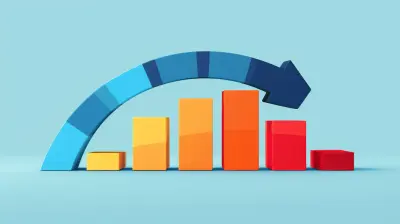Understanding Fixed vs. Variable Interest Rates
17 October 2025
Have you ever felt your eyes glaze over when a loan officer throws around terms like “fixed” and “variable” interest rates? Don’t worry — you’re not alone. These terms are tossed around as if we were all born knowing what they mean. But the truth is, most of us need a little help breaking them down, especially if we’re about to borrow big money for a mortgage, car loan, student loan, or even a credit card.
Let’s walk through it together. In this article, we're diving deep into the world of interest rates to uncover the real difference between fixed and variable rates. By the end, you’ll feel confident enough to make the right call for your finances — no financial jargon dictionary required.
What Are Interest Rates, Anyway?
Before we get into the whole "fixed vs. variable" debate, let’s take a quick refresher on what interest rates are.Think of interest as the cost of borrowing money. When you take out a loan, you're not just promising to pay back what you borrowed — you're also promising to pay a little extra. That "extra" is the lender’s way of saying, “Thanks for letting me lend you money!”
Now, how much interest you pay depends on the rate. And that rate can either stay the same (fixed) or change (variable). Sounds simple enough, right? Not so fast — the details make a BIG difference for your wallet.
Fixed Interest Rates: The Reliable Road Trip Buddy
So, What Is a Fixed Interest Rate?
A fixed interest rate is like that one friend who's always on time, consistent, and never flakes. When your loan has a fixed rate, your interest rate — and often your monthly payment — stays exactly the same for the entire term of the loan.Why People Love Fixed Rates
- Predictability: Knowing exactly what you’ll owe every month gives you peace of mind and makes budgeting a whole lot easier.- Protection from Market Changes: If interest rates skyrocket, guess what? You won’t feel it. You're locked in, and that’s a good thing.
When Fixed Rates Make Sense
- Long-term loans: Like mortgages or student loans that stretch over 10, 15, or 30 years.- Stable rate environments: When market interest rates are low and likely to rise, locking in a fixed rate is a smart move.
- If you like predictability: Hate surprises? Fixed rates keep them off your financial radar.
The Flip Side of Fixed Rates
Nothing’s perfect, and fixed rates have their downsides too:- Usually start higher: Compared to variable rates, you might pay more upfront.
- You might miss savings: If market rates drop, you're stuck with the higher rate unless you refinance.
Variable Interest Rates: The Wild Roller Coaster Ride
What’s a Variable Interest Rate?
A variable interest rate — also called a floating or adjustable rate — changes over time. These rates are tied to a benchmark (like the prime rate or LIBOR), and as that benchmark goes up or down, your rate (and payment) can too.Why Some Choose Variable Rates
- Lower starting rates: Many variable rate loans begin with lower rates than fixed. That can mean smaller monthly payments — at least at first.- Potential savings: If market rates drop, so does your rate. You could end up saving big.
When Variable Rates Might Work for You
- Short-term borrowers: Planning to pay off the loan quickly? You might benefit from the lower initial rate before it goes up.- Interest rate trends: If economists predict rates will stay low (or drop), variable rates can be strategic.
- Comfortable with risk: If you’re financially stable and can handle some ups and downs in your payment, go for it.
But... Here’s the Risk
- Unpredictability: Your payment can go up — sometimes by a lot. That can throw a wrench in your budget.- Complex terms: Some variable rate loans have caps, floors, and adjustment schedules — it’s easy to get lost in the fine print.
- Stress factor: If you worry easily, this uncertainty may drive you up the wall.

Fixed vs. Variable Interest Rates: A Side-By-Side Look
| Feature | Fixed Interest Rate | Variable Interest Rate ||----------------------------------|-----------------------------------|-------------------------------------|
| Interest Rate | Stays the same | Changes based on a benchmark |
| Monthly Payment | Consistent | Can increase or decrease |
| Best For | Long-term stability | Short-term savings or low-term risk|
| Initial Rate | Higher | Lower |
| Reaction to Market Changes | Unaffected | Sensitive to rate changes |
| Long-Term Cost | Predictable, sometimes higher | Can be unpredictable |
Real-Life Scenarios to Help You Choose
Still not sure which rate type works best for you? Let’s look at some relatable situations.Scenario 1: The Steady Saver
Imagine you're buying your first house. You're planning to stay for 15+ years and want to know exactly what your mortgage payment will be until the very last one.- ✅ Go fixed. The reliability helps with budgeting and long-term stability.
Scenario 2: The Fast Tracker
You’ve taken out a student loan, but you're sure you’ll pay it off in 3 years max thanks to a well-paying job offer.- ✅ Go variable. You could save money with lower payments during the short time you’ll have the loan.
Scenario 3: The Gambler (With a Cushion)
You have a decent emergency fund, your job is stable, and you like to take calculated risks.- ✅ Go variable. If the rates stay low, you win. If they go up, you’ve got a cushion to fall back on.
Pro Tips for Choosing Between Fixed and Variable Rates
Not everything’s black and white, right? Here are a few tips to help you make the smartest decision:1. Know Your Timeline
How long will you keep the loan? If it’s short term, a variable rate could save you. Long term? Fixed is safer.2. Consider Your Budget Flexibility
Can your budget handle a possible payment hike? If it can’t, stick with fixed. Peace of mind is priceless.3. Watch the Market
Interest rates don’t change on a whim. There are trends and forecasts. Follow financial news or talk to a trusted advisor.4. Check the Fine Print
Some variable rate loans have rate caps (how high they can go) or monthly/annual adjustments. Ask detailed questions before signing.5. Think Beyond the Rate
Yes, the interest rate is important, but don’t forget to factor in fees, loan terms, and penalties. A “good rate” can still be part of a bad deal.What About Credit Cards?
Surprise twist — most credit cards have variable interest rates tied to the prime rate. That’s why your credit card APR can change even if you didn’t do anything differently.If you're paying your balance in full, the rate change may not affect you at all. But if you carry a balance, rising rates can cost you more over time.
Refinancing: Changing Your Mind (And Your Rate)
You’re not locked in forever with either option! Depending on your loan type, you might have the option to refinance.- From variable to fixed: Great when rates start to climb and you want to lock in before it gets worse.
- From fixed to variable: Might make sense if rates drop and you want to lower your monthly payment (but tread carefully).
Just remember — refinancing often comes with fees. Do the math to make sure it’s worth it.
Final Thoughts: Which One Should You Choose?
There’s no “one-size-fits-all” when it comes to loans. The decision between fixed and variable interest rates depends on your personal situation, goals, and risk tolerance.- Want peace of mind and a predictable budget? Fixed is your friend.
- Want to (possibly) save more by taking on a bit of risk? Variable might be the way to go.
Either way, understanding the pros and cons can help you avoid costly mistakes.
So next time someone asks, “Fixed or variable?” — you won’t just answer. You’ll answer like a pro.
all images in this post were generated using AI tools
Category:
Interest RatesAuthor:

Zavier Larsen
Discussion
rate this article
1 comments
Noelle McAdams
Thank you for such a clear and informative article on fixed versus variable interest rates. Your straightforward explanations really help demystify a complex topic. It's crucial for consumers to understand these differences, and you've made it accessible. I appreciate your efforts in educating us!
October 22, 2025 at 10:23 AM

Zavier Larsen
Thank you for your kind words! I’m glad you found the article helpful and informative. Your feedback means a lot!


